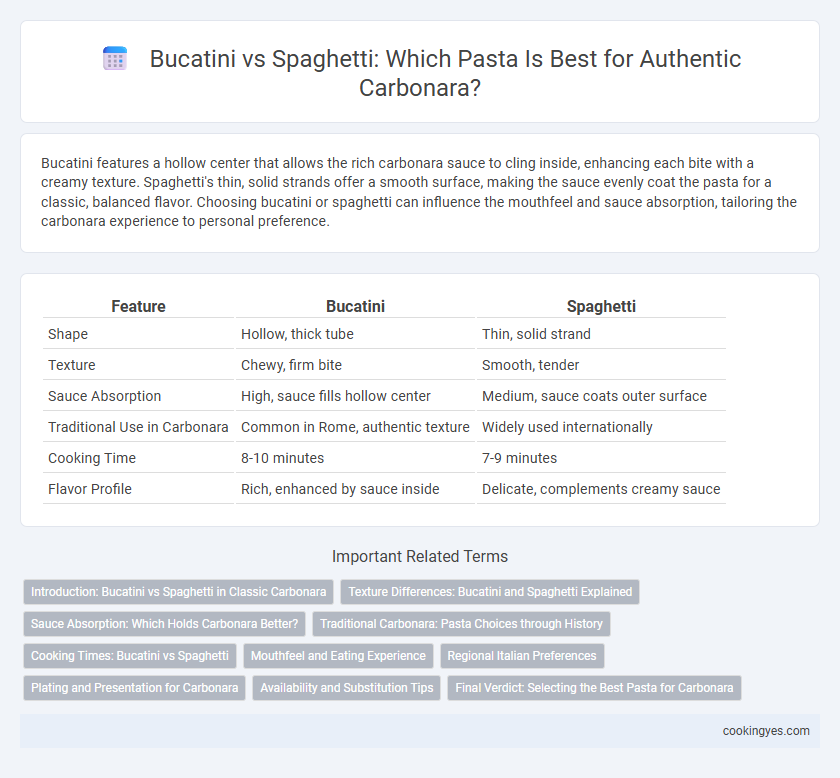Bucatini features a hollow center that allows the rich carbonara sauce to cling inside, enhancing each bite with a creamy texture. Spaghetti's thin, solid strands offer a smooth surface, making the sauce evenly coat the pasta for a classic, balanced flavor. Choosing bucatini or spaghetti can influence the mouthfeel and sauce absorption, tailoring the carbonara experience to personal preference.
Table of Comparison
| Feature | Bucatini | Spaghetti |
|---|---|---|
| Shape | Hollow, thick tube | Thin, solid strand |
| Texture | Chewy, firm bite | Smooth, tender |
| Sauce Absorption | High, sauce fills hollow center | Medium, sauce coats outer surface |
| Traditional Use in Carbonara | Common in Rome, authentic texture | Widely used internationally |
| Cooking Time | 8-10 minutes | 7-9 minutes |
| Flavor Profile | Rich, enhanced by sauce inside | Delicate, complements creamy sauce |
Introduction: Bucatini vs Spaghetti in Classic Carbonara
Bucatini and spaghetti offer distinct textures that influence the classic carbonara experience. Bucatini's hollow center captures rich, creamy sauce, intensifying each bite, while spaghetti's smooth, thin strands provide a lighter, more delicate coating of the traditional mixture of eggs, Pecorino Romano, guanciale, and black pepper. Choosing between these pastas depends on whether a fuller sauce embrace or a streamlined texture is preferred in authentic Roman carbonara.
Texture Differences: Bucatini and Spaghetti Explained
Bucatini features a hollow center that creates a chewier texture and allows the carbonara sauce to cling both inside and outside the pasta, enhancing flavor absorption. Spaghetti offers a smooth, solid structure with a slightly firmer bite that lets the creamy sauce coat its surface evenly. The hollow nature of bucatini provides a more intense taste experience, while spaghetti delivers a traditional, balanced texture preferred for classic carbonara.
Sauce Absorption: Which Holds Carbonara Better?
Bucatini's hollow center allows it to trap the creamy carbonara sauce, enhancing every bite with rich flavor compared to spaghetti's smooth surface, which causes the sauce to cling less effectively. The thickness of bucatini also provides a sturdier texture, holding the eggs and cheese mixture better without becoming overly saturated. For a carbonara that delivers maximum sauce absorption and flavor concentration, bucatini is the superior choice.
Traditional Carbonara: Pasta Choices through History
Bucatini and spaghetti have both played significant roles in the history of traditional Carbonara, with spaghetti being more commonly recognized in classic Roman recipes. Bucatini, with its hollow center, offers a unique texture that captures the creamy carbonara sauce more effectively, enhancing the dish's richness. Historically, spaghetti's long, thin strands were preferred for their ability to evenly coat the eggs and guanciale, maintaining the authentic balance of flavors that define traditional Carbonara.
Cooking Times: Bucatini vs Spaghetti
Bucatini typically requires 9 to 11 minutes to reach al dente, slightly longer than spaghetti's 8 to 10 minutes, impacting the preparation timing for Carbonara. The thicker, hollow structure of bucatini allows it to hold more sauce, including the creamy egg and cheese mixture essential to Carbonara, but demands careful timing to avoid overcooking. Spaghetti's thinner strands cook faster and deliver a more delicate texture, blending smoothly with Carbonara's rich ingredients while requiring less precise timing in boiling.
Mouthfeel and Eating Experience
Bucatini's hollow center creates a unique, satisfying mouthfeel, allowing the creamy carbonara sauce to cling inside each strand, enhancing the overall eating experience. Spaghetti offers a classic, smooth texture that evenly coats with sauce, delivering a familiar yet delightful bite. The slight chewiness of bucatini contrasts with spaghetti's tenderness, making it ideal for those seeking a more textured, immersive meal.
Regional Italian Preferences
Bucatini is traditionally favored in Rome for authentic Carbonara due to its hollow center, which traps the creamy sauce, enhancing every bite with rich flavors. In contrast, spaghetti is widely preferred in other Italian regions, offering a familiar texture that balances the pancetta and egg mixture without overshadowing the sauce. Regional Italian preferences highlight that Bucatini captures the classic Roman essence, while spaghetti provides versatility across diverse local interpretations.
Plating and Presentation for Carbonara
Bucatini, with its hollow center, holds Carbonara sauce more effectively, creating a visually rich and textured presentation that highlights every strand coated in creamy egg and pancetta. Spaghetti offers a classic, sleek appearance with a smooth surface that elegantly showcases the glossy sauce without overpowering the plate's aesthetics. Choosing bucatini enhances the dish's rustic appeal, while spaghetti delivers a refined, minimalist presentation ideal for upscale dining.
Availability and Substitution Tips
Bucatini offers a thicker, hollow texture that holds Carbonara sauce well but can be harder to find in some grocery stores compared to the widely available spaghetti. When bucatini is unavailable, substituting with spaghetti or even thick linguine maintains the creamy sauce consistency needed for authentic Carbonara. For best results, choose pasta with a rough texture to help the egg and cheese mixture cling evenly.
Final Verdict: Selecting the Best Pasta for Carbonara
Bucatini's hollow center allows it to hold more creamy carbonara sauce, creating a richer texture compared to spaghetti's thin strands. Spaghetti offers a classic, familiar bite that evenly coats the sauce, ideal for traditionalists seeking simplicity. The best choice ultimately depends on whether you prefer a sauce-loaded experience (bucatini) or a balanced, traditional presentation (spaghetti).
Bucatini vs Spaghetti for Carbonara Infographic

 cookingyes.com
cookingyes.com